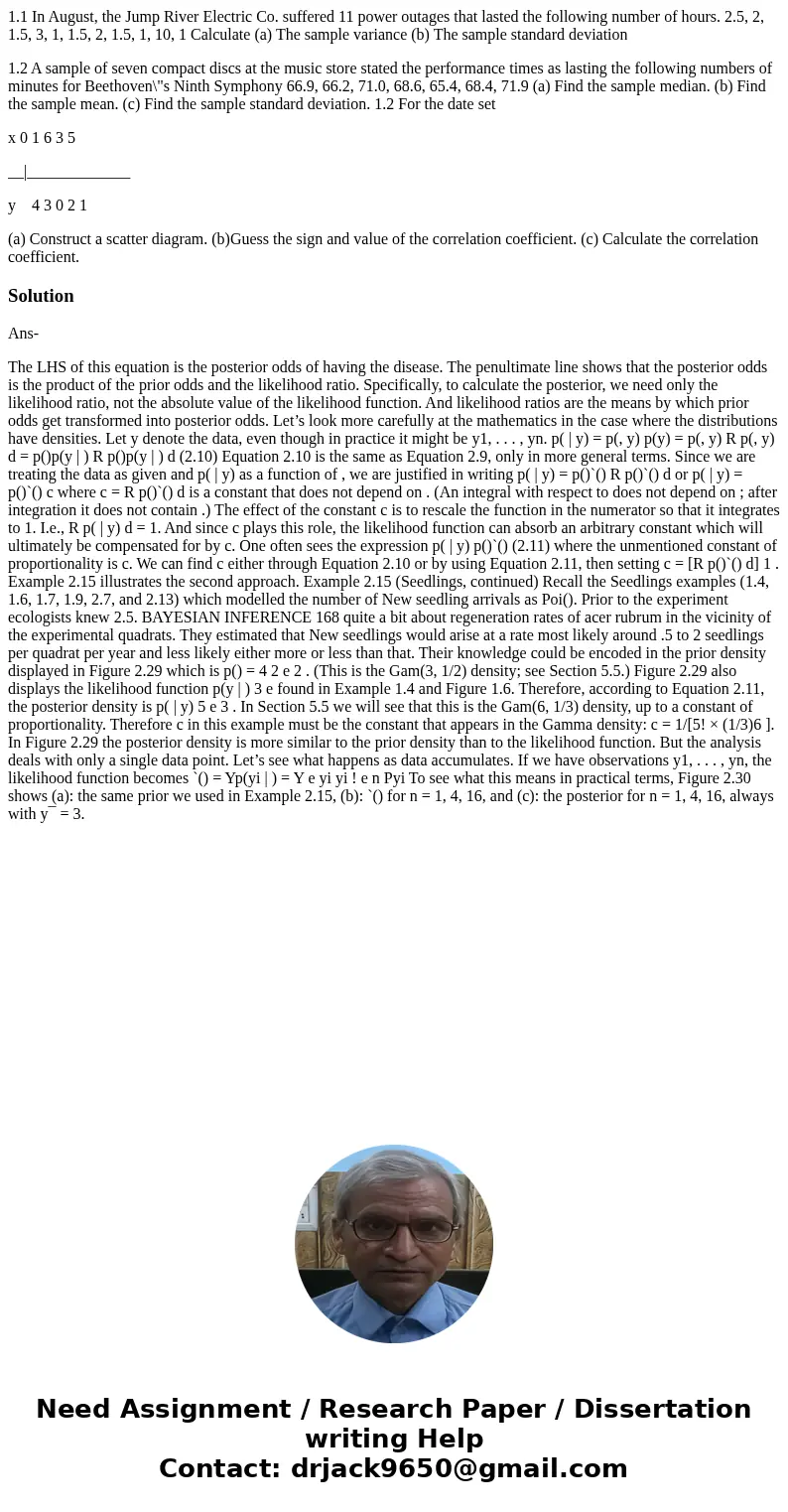11 In August the Jump River Electric Co suffered 11 power ou
1.1 In August, the Jump River Electric Co. suffered 11 power outages that lasted the following number of hours. 2.5, 2, 1.5, 3, 1, 1.5, 2, 1.5, 1, 10, 1 Calculate (a) The sample variance (b) The sample standard deviation
1.2 A sample of seven compact discs at the music store stated the performance times as lasting the following numbers of minutes for Beethoven\"s Ninth Symphony 66.9, 66.2, 71.0, 68.6, 65.4, 68.4, 71.9 (a) Find the sample median. (b) Find the sample mean. (c) Find the sample standard deviation. 1.2 For the date set
x 0 1 6 3 5
__|_____________
y 4 3 0 2 1
(a) Construct a scatter diagram. (b)Guess the sign and value of the correlation coefficient. (c) Calculate the correlation coefficient.
Solution
Ans-
The LHS of this equation is the posterior odds of having the disease. The penultimate line shows that the posterior odds is the product of the prior odds and the likelihood ratio. Specifically, to calculate the posterior, we need only the likelihood ratio, not the absolute value of the likelihood function. And likelihood ratios are the means by which prior odds get transformed into posterior odds. Let’s look more carefully at the mathematics in the case where the distributions have densities. Let y denote the data, even though in practice it might be y1, . . . , yn. p( | y) = p(, y) p(y) = p(, y) R p(, y) d = p()p(y | ) R p()p(y | ) d (2.10) Equation 2.10 is the same as Equation 2.9, only in more general terms. Since we are treating the data as given and p( | y) as a function of , we are justified in writing p( | y) = p()`() R p()`() d or p( | y) = p()`() c where c = R p()`() d is a constant that does not depend on . (An integral with respect to does not depend on ; after integration it does not contain .) The effect of the constant c is to rescale the function in the numerator so that it integrates to 1. I.e., R p( | y) d = 1. And since c plays this role, the likelihood function can absorb an arbitrary constant which will ultimately be compensated for by c. One often sees the expression p( | y) p()`() (2.11) where the unmentioned constant of proportionality is c. We can find c either through Equation 2.10 or by using Equation 2.11, then setting c = [R p()`() d] 1 . Example 2.15 illustrates the second approach. Example 2.15 (Seedlings, continued) Recall the Seedlings examples (1.4, 1.6, 1.7, 1.9, 2.7, and 2.13) which modelled the number of New seedling arrivals as Poi(). Prior to the experiment ecologists knew 2.5. BAYESIAN INFERENCE 168 quite a bit about regeneration rates of acer rubrum in the vicinity of the experimental quadrats. They estimated that New seedlings would arise at a rate most likely around .5 to 2 seedlings per quadrat per year and less likely either more or less than that. Their knowledge could be encoded in the prior density displayed in Figure 2.29 which is p() = 4 2 e 2 . (This is the Gam(3, 1/2) density; see Section 5.5.) Figure 2.29 also displays the likelihood function p(y | ) 3 e found in Example 1.4 and Figure 1.6. Therefore, according to Equation 2.11, the posterior density is p( | y) 5 e 3 . In Section 5.5 we will see that this is the Gam(6, 1/3) density, up to a constant of proportionality. Therefore c in this example must be the constant that appears in the Gamma density: c = 1/[5! × (1/3)6 ]. In Figure 2.29 the posterior density is more similar to the prior density than to the likelihood function. But the analysis deals with only a single data point. Let’s see what happens as data accumulates. If we have observations y1, . . . , yn, the likelihood function becomes `() = Yp(yi | ) = Y e yi yi ! e n Pyi To see what this means in practical terms, Figure 2.30 shows (a): the same prior we used in Example 2.15, (b): `() for n = 1, 4, 16, and (c): the posterior for n = 1, 4, 16, always with y¯ = 3.

 Homework Sourse
Homework Sourse